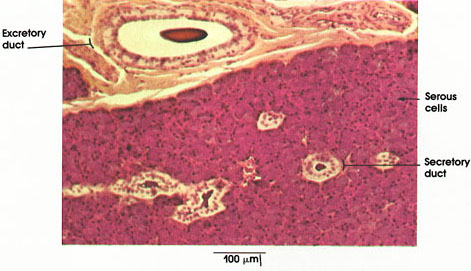

Plate 10.209 Parotid Gland
Ronald A. Bergman, Ph.D., Adel K. Afifi, M.D., Paul M. Heidger,
Jr., Ph.D.
Peer Review Status: Externally Peer Reviewed

Human, 10% formalin, H. & E., 162 x.
Salivary secretion is essential to the swallowing process and for taste. In addition, the salivary secretion continuously rinses the oral cavity and is antimicrobial. Digestion begins in the mouth, where the food is mixed with saliva, and continues in the stomach, within the bolus of chewed and moistened food, until the acid gastric juices penetrate the bolus. The parotid gland produces about one fourth of the daily output of 1 liter of saliva. In man and dog, the watery secretion of parotid gland acini is modified by the striated ducts through the absorption of sodium and chloride, producing a saliva hypotonic with respect to blood. With increased flow of saliva, the reabsorption of these salts fails to keep pace, and the sodium concentration increases. The epithelium of the parotid ducts also excretes iodide into the saliva.
The secretion of salivary glands is dependent upon their innervation, and each major gland is supplied by both sympathetic and parasympathetic nerves. Although the specific role of the sympathetic innervation is still uncertain, it would appear that, under normal circumstances, the sympathetic fibers are inhibitory and parasympathetic stimulation is secretory.
Excretory duct: In the connective tissue septa. Simple columnar epithelial lining. Gradation to stratified epithelium occurs as the duct approaches the main outlet.
Secretory duct: Cuboidal to low columnar epithelial lining depending on location and size. Found in connective tissue septa within lobules of the gland.
Serous cells: Form a circular cluster of pyramidal cells with a central lumen (acinus). Acini of the human parotid gland are purely serous. The serous secretion is watery and contains salts, proteins, and amylase. Amylase is an enzyme that splits starch and glycogen into smaller carbohydrates, dextrins, and maltose. Acinar cells have basal nuclei and secretory granules, which are found between the free or luminal surface and the nucleus.
Next Page | Previous Page | Section Top | Title Page
Please send us comments by filling out our Comment Form.
All contents copyright © 1995-2024 the Author(s) and Michael P. D'Alessandro, M.D. All rights reserved.
"Anatomy Atlases", the Anatomy Atlases logo, and "A digital library of anatomy information" are all Trademarks of Michael P. D'Alessandro, M.D.
Anatomy Atlases is funded in whole by Michael P. D'Alessandro, M.D. Advertising is not accepted.
Your personal information remains confidential and is not sold, leased, or given to any third party be they reliable or not.
The information contained in Anatomy Atlases is not a substitute for the medical care and advice of your physician. There may be variations in treatment that your physician may recommend based on individual facts and circumstances.
URL: http://www.anatomyatlases.org/